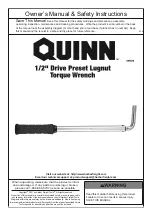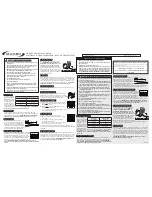
ENGLISH
17
If battery fluid leaks out and comes into contact with
your skin, rinse immediately with plenty of water. If bat-
tery fluid leaks out and comes into contact with your
eyes, wash them with clean water and seek medical
attention immediately!
Transporting li-ion battery packs:
The contained lithium-ion batteries are subject to the Dan-
gerous Goods Legislation requirements. The user can transport the batteries by road without fur-
ther requirements. When being transported by third parties (e.g.: air transport or forwarding
agency), special requirements on packaging and labelling must be observed. For preparation of
the item being shipped, consulting an expert for hazardous material is required. Only send the
battery pack if the housing is intact and no fluid is leaking. Remove the battery pack from the
machine for sending. Prevent the contacts from short-circuiting (e.g. by protecting them with ad-
hesive tape).
Dispatch batteries only when the housing is undamaged. Tape or mask off open contacts and
pack up the battery in such a manner that it cannot move around in the packaging. Please also
observe possibly more detailed national regulations.
2
Technical data BACFP
Battery voltage ................................................................
18 V
Battery capacity. ................................................................
2,0 Ah / 4,0 Ah
Rated power consumption ................................540 W
Motor speed. ................................................................
22000 min
-1
Maximum piston force ..........................................................
max. 34 kN
Pressing time (according to nominal size) .............................
ca. 5 s
Dimensions (L x W x H) ........................................................
450 x 125 x 79 mm
Weight (without battery) ........................................................
ca. 2,9 kg
Working range. (system- dependent) ................................
Ø 12 – 108 mm
Application temperature range ................................
-10 – 60°C / 14 – 140°F
Operating mode ................................................................
S3
Sound pressure level (L
pA
) ................................71 dB (A) ¦ K
pA
3 dB (A)
Sound power level (L
WA
) .......................................................
82 dB (A) ¦ K
WA
3 dB (A)
The noise level during operation can exceed 85 dB (A). Wear ear protection!
Measurements found in compliance with EN 60745-1.
Vibration total value ..............................................................
≤ 2,5 m/s
2
¦ K= 1,5m/s
2
The vibration level given in this information sheet has been measured in accordance with a
standardised test given in EN 60745 and may be used to compare one tool with another. It may
be used for a preliminary assessment of exposure.
The declared vibration emission level represents the main applications of the tool.
However if the tool is used for different applications, with different accessories or
insertion tools or is poorly maintained, the vibration emission may differ. This may
significantly increase the exposure level over the total working period.
An estimation of the level of exposure to vibration should also take into account the
times when the tool is switched off or when it is running but not actually doing the
job. This may significantly reduce the exposure level over the total working period.
Identify additional safety measures to protect the operator from the effects of vibra-
tion such as: maintain the tool and the accessories, keep the hands warm, organisa-
tion of work patterns.
Summary of Contents for 368870
Page 3: ...C D LeD Insert Press Jaw 1 3 2...
Page 4: ...e operating 1 2 3 LeD stARt...
Page 193: ...Notes...
Page 194: ...Notes...
















































